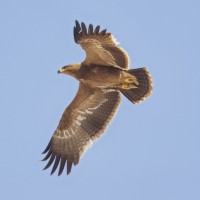Opis
The staggering pink-and-white slopes of the Caucasus mountain foothills in the Khizi region have earned them the name of the “Candy Cane Mountains”. The area is known for several species of lower mountain habitats and it is a nice side trip during a spring visit to Besh Barmag or a drive between Baku and the Greater Caucasus Mountains. Among the birds you can encounter in the area are Kowalik duży, góropatwa azjatycka, trznadel czarnogłowy, słowik syberyjski, orzeł stepowy, raróg górski, bialorzytka bialogrzbieta, pasterz, kraska, dzierzba rudogłowa, ścierwnik, Black Vulture, sęp płowy and pustułeczka.
Szczegóły
Dostęp
One of Azerbaijan’s most beautiful stretches of road leads for about 40 kilometres from the Guba-Baku highway west towards the mountain village of Altiaghaj. Roughly mid-way between the two one passes through a dramatic valley flanked by rolling shale mountains whose astonishing red, orange, pink and chalk-coloured swirls led British travel writer Mark Elliott (author of the very popular 'Azerbaijan' guidebook) to dub them the Candy Cane Mountains, a name that’s stuck with travellers ever since. The astonishing colours are said to be due to groundwater that’s altered the oxidation state of iron compounds within the rock. If taking an organised hike here, which can be booked through tour companies in Baku and is preferably undertaken in autumn or spring, glance down beneath your feet: you may discover tiny fossils and perhaps even a squid-like belemnite from the cretaceous period.
Teren i siedlisko
Góry , Rzadkie drzewa i krzewy , Łąka , Miasto/wieś , Rolnictwo/uprawyWarunki
Górzysty , Pagórkowaty , SuchyTrasa dookoła
TakCzy luneta będzie przydatna ?
Może być przydatnaUdany sezon obserwacyjny
Wiosna , LatoNajlepszy czas na wizytę
Lato , WiosnaTrasa
Droga utwardzona , Szeroka ścieżkaPoziom trudności szlaku pieszego
ForsownyDostępne
Pieszo , SamochódCzatownia/platforma obserwacyjna
NieDodatkowe informacje
The corridor between the mountains and the sea is a birdwatching site of global significance and you can climb from here to the top of Beshbarmag Mountain to witness stunning views and intriguing spiritual rituals.




